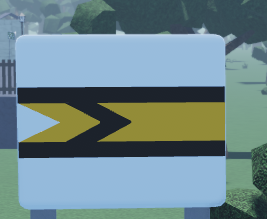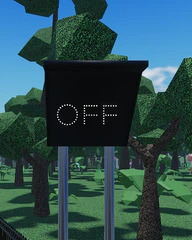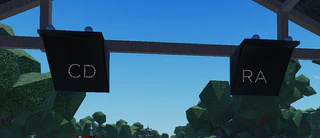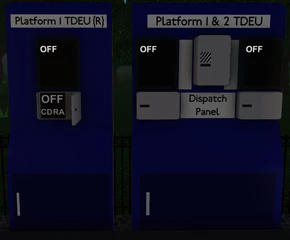A signal is a tool that displays an indication of the track status ahead for drivers. There are several types of signals listed below that can be found in game. All of the signals are controlled by Signal Boxes. Refer to the Signalling Guide to learn how to operate signal boxes.
Signal Mechanisms
Railway signals take many shapes and forms which have evolved with time. In the United Kingdom, the semaphore signal quickly became the standard for railways until their gradual replacement with modern colour light signals.
Semaphore Signal
A semaphore signal is comprised of a rotating semaphore arm mounted at the top of a post or gantry, and a light behind a set of lenses which move with the arm. When a semaphore arm is in the horizontal position, it is referred to as being 'on'. When it is raised or lowered by 45 degrees, it is referred to as being 'off'. Signals that raise when off are known as upper quadrant signals, and those that lower are known as lower quadrant signals.
Colour Light Signal
Colour light signals utilise much brighter lights than semaphores, allowing the signal aspect to be seen clearly during the day without need for a physically moving signal. The lack of mechanical operation meant that colour lights were easier to maintain, more reliable, and often a similar price to installing new semaphores.
Colour light signals consist of multiple lights stacked vertically in a housing. Since more than two indications are possible per signal, one colour light signal could often replace a pair of stop and distant semaphore signals.
Stop Signal
Stop signals are the simplest type of signal, informing a driver if they have authority to proceed past the signal. The clearance of a stop signal proves to a driver that the route ahead is clear of an obstruction.
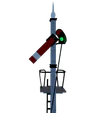
When cleared, stop signals:
- Allow the driver to proceed past the signal until the next stop signal reached.
- Are raised or lowered at a 45 degree angle. (Semaphore)
- Display a green light.
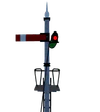
When at danger, stop signals:
- Do not allow the driver to pass the signal.
- Are horizontal; at a 90 degree angle. (Semaphore)
- Display a red light.
All controlled stop signals have a nameplate mounted to their post or gantry labelled with the code of the signal box controlling the signal and the corresponding signal and lever number for that box. When mounted alongside other signals, only one label may be provided.
Most semaphore stop signals are provided with a white diamond sign on the post. These indicate that the presence of a train is repeated in the signal box, and drivers do not need to notify the signaller if they are waiting at it.
Distant Signal
Distant signals provide advanced warnings as to whether the next stop signals will be at danger or not. This is necessary due to the long braking distance of trains.
If the signal is at caution, you must slow down, expecting the next stop signal to be at danger. The indication of a distant signal applies to all signals until the next distant signal or fixed distant board, so you must be prepared to stop at all other stop signals even if the first one is cleared.
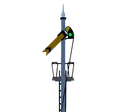
When cleared, distant signals:
- Inform the driver all associated stop signals are cleared.
- Are raised or lowered at a 45 degree angle. (Semaphore)
- Display a green light.

When at caution, distant signals:
- Inform the driver that they should expect one of the following stop signals to be at danger and must slow down.
- Are horizontal; at a 90 degree angle. (Semaphore)
- Display a yellow light.
Distant signals do not require a nameplate, however if one is provided, a white triangle is marked on the plate to indicate that the associated signal cannot show a danger indication.
Fixed distant boards
At some places where a distant signal would almost never be in the off position or would require a significant slow down on approach, a board displaying a semaphore distant with a fixed caution indication may be found. These boards should be treated as a distant signal displaying caution. A fixed distant may also take the form of a normal semaphore displaying a caution indication which cannot be changed.
Shunt Discs
Shunt discs comprise of a small white disc with a central red band. They are generally found at sidings, yards, or routes on the mainline against the normal direction of traffic, and are often mounted on the ground. Unlike a normal stop signal, shunt discs only allow a train to proceed as far as the line is clear, preparing to stop short of an obstruction, so may be used to signal trains into an occupied area.

When cleared, shunt discs:
- Allow the driver to proceed at caution as far as the line is clear.
- Are rotated 45 degrees.
- Display a green light.

When at danger, shunt discs:
- Do not allow the driver to pass the signal.
- Are horizontal.
- Display a red light.
Yellow shunt discs
A yellow shunt disc can sometimes be found at a head shunt, comprising a yellow band on a white or black painted disc. Despite being yellow, these signals are unrelated to distant signals.

When in the off position, yellow shunt discs:
- Allow the driver to proceed at caution as far as the line is clear.
- Are rotated 45 degrees.
- Display a green light.
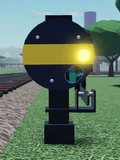
When in the on position, yellow shunt discs:
- Allow the driver to pass the signal towards the head shunt or siding, but not towards the running line.
- Are horizontal.
- Display a yellow light.
Semaphore Subsidiary Signal
Subsidiary signals can be found mounted alongside stop signals. They allow the driver to proceed under special circumstances which are not normally permitted. When cleared, subsidiary signals display a small letter which indicates the type of subsidiary signal.
"C" represents a calling-on signal (Currently the only type of subsidiary signal in-game.) When cleared, this type of signal allows a driver to proceed as far as the line is clear, preparing to stop short of an obstruction. A driver may therefore enter a block occupied by another vehicle. These are generally only found at platforms, and are primarily used for the coupling of multiple vehicles.
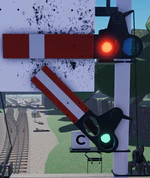
When cleared, subsidiary signals:
- Allow the driver to pass under the specified instruction displayed.
- Are raised or lowered at a 45 degree angle.
- Display a green light.
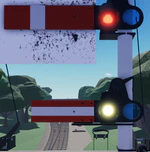
When at danger the driver must obey the associated stop signal. At danger, subsidiary signals:
- Are horizontal; at a 90 degree angle.
- Display a white light.
Juction Signals
Whenever a line can diverge to multiple routes, a driver is always provided with an indication of which route they will take, often informing them whether they must slow down to safely traverse a junction. This principle is known as route signalling, a system which is currently used in few locations including the majority of the United Kingdom.
Gantry Signals
Stop signals mounted alongside each other on a gantry indicate multiple routes and their associated directions. The relative height of each signal indicates the speed (and often importance) of each route, with lower mounted signals representing a route with a reduced speed limit. Signals at the same height indicate a shared speed limit. The gantry may be passed if any one signal is cleared.
The same principle applies to gantry mounted distant signals, with each signal indicating a separate route. Shunt discs and subsidiary signals can also be found mounted on gantries, often indicating a route towards a siding or for other shunting movements.
Note that gantry signals displaying diverging routes should not be confused with signals mounted alongside each other on a gantry but applying to different lines or platforms. Signals applying to separate lines can be identified by significant spacing, and will be mounted directly above the line they apply to.
Route Indicators
Instead of using separate signals to indicate routes, a device called a route indicator can be used to display several different routes to a driver whilst only requiring a single signal.
Route indicators are generally comprised of a box located under a stop signal, which can display different numbers, letters or words, each signifying a platform number or line. These indications can be displayed mechanically by moving lettered cards, or electrically with dot matrix lights or fibre-optic displays. The route displayed is controlled by the position of the points ahead, and is automatically shown when the signal is cleared.
Stacked Shunt Discs
Shunt discs can often be found stacked atop each other, with each disc indicating a separate route. The discs are read top to bottom, left to right, meaning that the top disc applies to the left-most route and so on.
Banner Repeater



Where the sighting of a signal is adversely affected by curvature or an intervening over bridge or station canopy, etc., an extra signal called a Banner Repeater can be installed to give drivers of approaching trains an earlier view of the indication shown.
These are similar to semaphore distant signals. When a banner repeater is at its 'on' state, with a horizontal line, it can be passed, but indicates that the stop signal ahead is at danger. When a banner repeater is at its 'off' state, with a diagonal line, it can be passed, and indicates that the stop signal ahead is cleared and can be passed safely. Unlike a distant signal however, the indication only repeats the first signal ahead of the banner repeater.
There are two types of Banner Repeater Signals in the game, one being digital, commonly found at stations and lit up on a dot matrix format, and the other being standard banner repeaters found on the line.
Banner repeaters can be found in places like Masonfield and on approach to Dovedale Central Station.
OFF/CD/RA Indicators
OFF Indicators are found at stations with dispatching capabilities, and are used to inform the driver if they can move on from the station, and what to do. They are controlled by Train Dispatch Equipment Units (TDEU), which can usually be found at the side of the platform. These are currently present at Masonfield, Dovedale Central and Fanory Mill, and could previously be found at Satus Services and Glassbury Junction.
- An illuminated OFF indication means the associated signal is off, displaying a proceed aspect.
- An illuminated CD indication (close doors) is an instruction to close the train's power-operated doors.
- An illuminated RA or R indication (right away) means that station duties are complete and the train may depart.
OFF - Signal ahead is cleared
CD - Close Doors
RA - Right Away
-
An OFF indicator showing OFF.
-
Dispatch indicators showing CD and RA respectively.
-
An old TDEU once located at Satus Services.
SPAD Indicator
A SPAD indicator may be positioned after a stop signal where there is a high likelihood of a serious collision should a SPAD (Signal Passed at Danger) occur at the signal. [1] They are normally unlit, but following a SPAD they display a steady red light between two flashing red lights arranged vertically. Any driver who sees a SPAD indicator illuminated must stop their train immediately and subsequently contact the signaller for further instructions, even if they can see that the signal pertaining to their line is showing a proceed aspect. SPAD indicators are mounted against a blue backplate with dot matrix lights.
Semaphore Signals Out of Use (Removed)

If a semaphore signal is out of use, whether due to failure or not being in operation, they are provided with a cross. Signals that are signed out of use are not to be obeyed. If they are accompanied by other signals that are in use, they must be obeyed. Signals in-game do not currently fail, so do not try to put crosses on signals.
The ability to 'cross up' signals was removed in Version 1.2, as signals were reworked to no longer break as in earlier versions.
